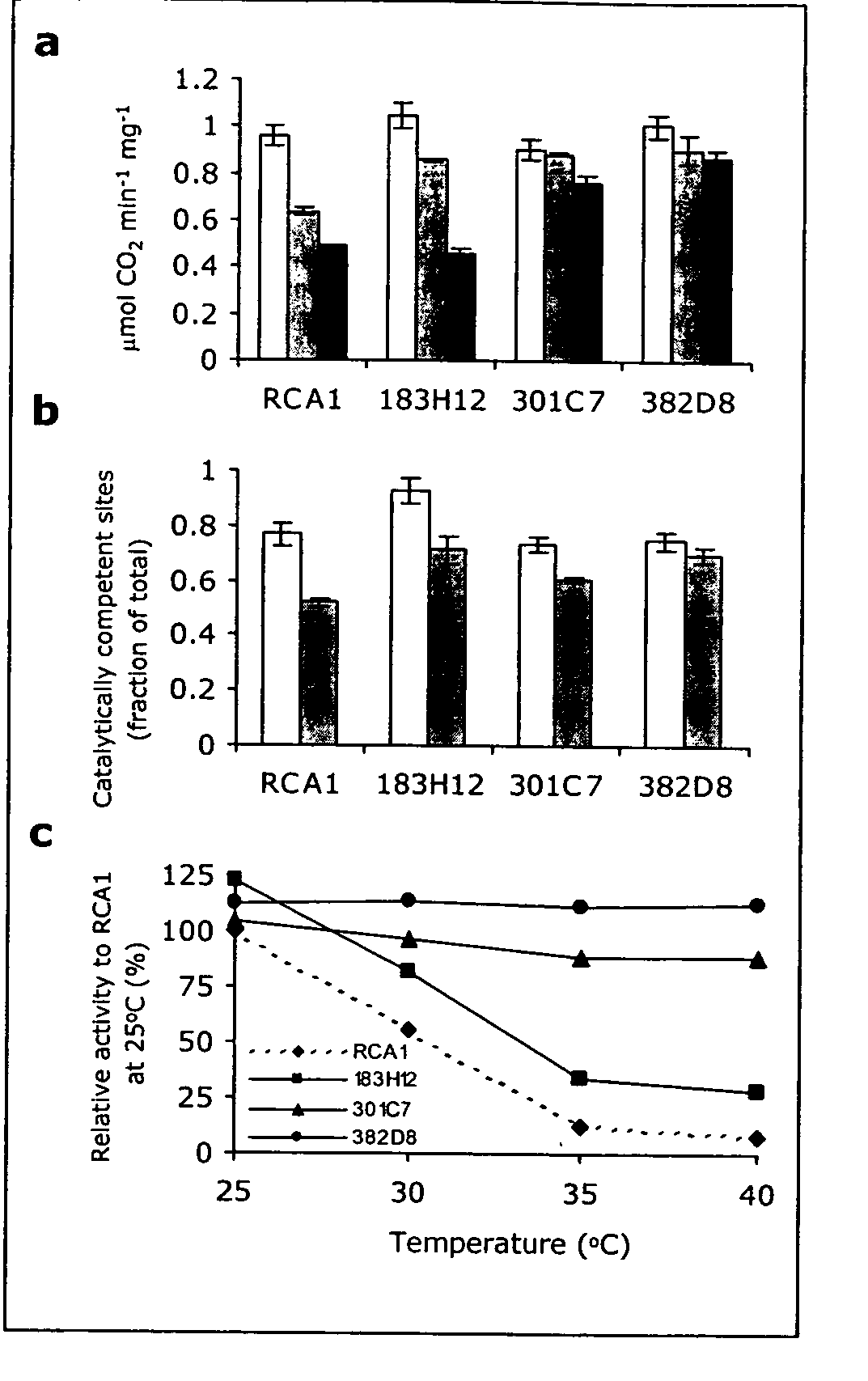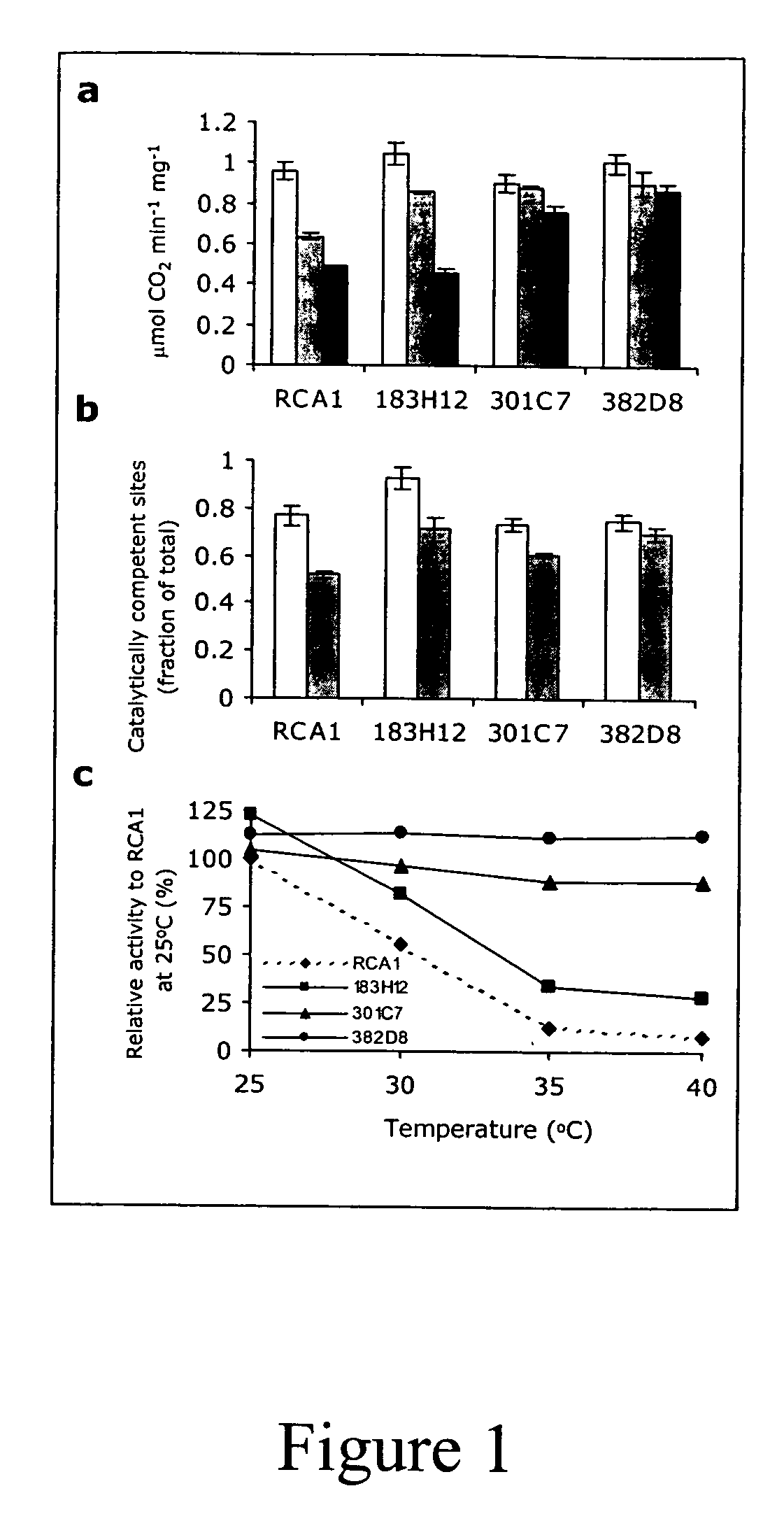Rubisco activase with increased thermostability and methods of use thereof
a thermostability and activase technology, applied in the field of activase of rubisco, can solve the problems of slow photosynthesis, rubisco remains inactive, and the rate-limiting step of rubisco photosynthesis
- Summary
- Abstract
- Description
- Claims
- Application Information
AI Technical Summary
Benefits of technology
Problems solved by technology
Method used
Image
Examples
example 1
Isolating Rubisco Activase Derived Polypeptides
[0091] Rubisco Activase libraries were generated from single gene shuffling (see, e.g., Crameri, et al., (1998) Nature. 391(6664):288-91; Chang, et al., (1999) Nat Biotechnol. 17(8):793-7; Ness, et al., (1999) Nat Biotechnol. 17(9):893-6; Christians, et al., (1999) Nat Biotechnol. 17(3):259-64 and U.S. Pat. Nos. 6,605,430; 6,117,679; and 5,605,793) and synthetic shuffling (see, e.g., U.S. Pat. No. 6,436,675 and International Publication Nos. WO 00 / 42561; WO 01 / 23401; WO 00 / 42560; and WO 00 / 42559) using wild type Rubisco Activase of SEQ ID NO: 1 as a template.
[0092] Briefly, Arabidopsis RNA was isolated from green leaves using Trizol® reagent according to the manufacturer's protocol (Invitrogen). RCA cDNA (GenBank accession number NM 179990) was PCR cloned into TOPO® vector (Invitrogen) using TITANIUM™ one-step RT-PCR Kit (BD Biosciences-Clontech). For single gene shuffling in the first round, the mature RCA short form (coding region V...
example 2
In vitro Characterization of Rubisco Activase Derived Polypeptides
[0101] The Rubisco Activase derived polypeptides isolated in Example 6.1 were tested in vitro in three different assays in order to determine the specific activity at 25° C. and 40° C. and their thermostability (t.s.). In all cases, the results obtained with wild type Rubisco Activase at 25° C. were set to 100%.
[0102] Activation of deactivated Rubisco. Purified Rubisco Activase derived polypeptides were assayed as described in the first tier assay of Example 1 except that the derived polypeptides were incubated at 40° C. or 45° C. for 15, 30, 45 or 60 minutes prior to performance of the Rubisco activation assay. Results are shown in columns 24 of Table 3. Column 2 of Table 3 represents the amount of activated Rubisco that is obtained after incubation of deactivated Rubisco with Rubisco Activase at 25° C. There were no heated conditions used. Column 3 of Table 3 represents the amount of Rubisco that has been activate...
example 3
Complementation of Rubisco Activase Deletion Mutant
[0108] In order to express shuffled variants in homozygous background for the deletion (Δrca / Δrca) (see, Li, et al., (2001) Plant J. 27:235-242) the following complementation cascade was developed: 1) Selection of heterozygous plants for the deletion by HTP-PCR using single-leaf 96-well DNA extraction method (Xin, et al., (2003) BioTechniques 34:820-826), with specific primers for the wild-type and deleted alleles. 2) Transformation with the gene of interest. 3) T0 selection for antibiotic resistance and PCR analysis for homozygosity. 4) Self pollination of the resultant homozygous plants in order to obtain T1 transgenic lines.
[0109] Immunoblot analysis of wild-type, heterozygous, and homozygous plants (genetic background RCA / RCA, RCA / Δrca and Δrca / Δrca respectively) revealed that the gene products (long and short forms) were expressed at similar levels in wild-type and heterozygous plants (FIG. 2A). The absence of the short and l...
PUM
| Property | Measurement | Unit |
|---|---|---|
| temperatures | aaaaa | aaaaa |
| Tm | aaaaa | aaaaa |
| Tm | aaaaa | aaaaa |
Abstract
Description
Claims
Application Information
 Login to View More
Login to View More - R&D
- Intellectual Property
- Life Sciences
- Materials
- Tech Scout
- Unparalleled Data Quality
- Higher Quality Content
- 60% Fewer Hallucinations
Browse by: Latest US Patents, China's latest patents, Technical Efficacy Thesaurus, Application Domain, Technology Topic, Popular Technical Reports.
© 2025 PatSnap. All rights reserved.Legal|Privacy policy|Modern Slavery Act Transparency Statement|Sitemap|About US| Contact US: help@patsnap.com



